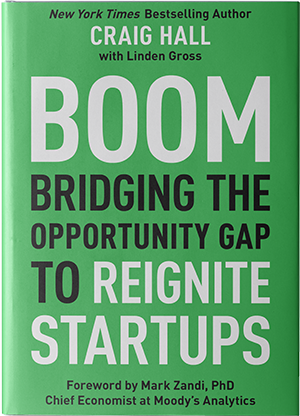Today, entrepreneurship in the U.S., despite its record media popularity, is in trouble. Despite entrepreneurship’s perceived momentum, the number of new startups today is approximately half of what it was thirty years ago.
There is no silver bullet to quickly bridge our country’s widening opportunity gap. However, there are many steps we can take to level the playing field.
This begins with creating widespread awareness of the issue. Truth starts with shining a light on the actual problem entrepreneurship in our country is facing and the need for us to come together and determine solutions. Hopefully, with more facts made available, Americans will agree it is in our interest as a country to level the playing field and provide opportunities for a broader base of Americans to become entrepreneurs.
Put the Right Policies in Place
Historically, we have been and should be again a country of hope and opportunity for all. To do that, we need policies that encourage opportunity for all Americans.
- Tax Plan for Small Businesses: We provide tax incentives for the rich to invest in real estate. Why not provide tax incentives for people to invest in startups, also? If people could invest in a new business started by an entrepreneur, both sides win. It’s not hard to put together tax plans that would incentivize many people who have the capital to invest in smaller companies. I’m not worried about the big ones, as there are huge venture capital funds that take care of them. But there are many startups outside of Silicon Valley, NYC, Boston and other hot tech markets that simply need access to capital.
- Invest in Women and Minorities: Morgan Stanley reports that women and minority-owned businesses receive 80 percent less investment than the median investment in businesses overall. We need to create public policies that incentivize private and institutional investment in women and minority-owned businesses, while also reforming current government programs and funding applications to focus more on these underserved entrepreneurs. The same is true in rural communities. We need to implement tax incentives in rural communities that encourage rural innovation and investment to create entrepreneurial ecosystems.
- Reduce Regulation: Beyond capital, let’s look at how we can reduce overbearing regulations on startups. The current regulatory climate in the U.S. is extremely difficult to navigate, leading our country to be ranked 53rd in ease of starting a new business, according to the World Bank. Many startups can’t afford the legal fees alone to get through these regulations. We should consider onboarding programs for new companies that only require the essential regulatory steps to be taken.
New Opportunities Through Nonprofits
One of the great strides being made today are entrepreneurship programs beginning in elementary, junior high, and high school and going on into higher education. Nonprofits such as the National Foundation for Teaching Entrepreneurship (NFTE), which are very active in public schools, are helping provide entrepreneurship-focused curriculum and experience to students. Junior Achievement is another nonprofit that has great programs for educating our nation’s youth about entrepreneurship as a career path.
While not everyone is going to be an entrepreneur, learning about entrepreneurship is a great tool to apply to any career. By introducing future generations and students of all races, ethnicities, and genders to entrepreneurship, we are able to begin creating new opportunities and access to entrepreneurship through these programs.
The appendix in my new book BOOM: Bridging the Opportunity Gap to Reignite Startups also lists several nonprofits and higher education programs that are focusing on advancing entrepreneurship for all Americans.
Adapted from Quora.
 Bridging the Opportunity Gap to Reignite Startups
Bridging the Opportunity Gap to Reignite Startups
There is an alarming decades-long decline of new business startups facing the United States today. BOOM exposes the reasons behind this downward spiral and outlines strategies to solve the problem.

